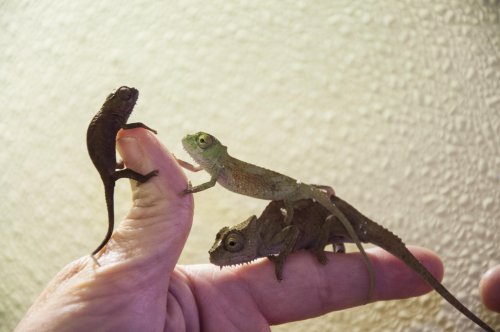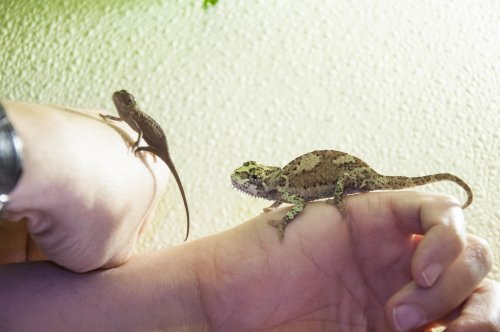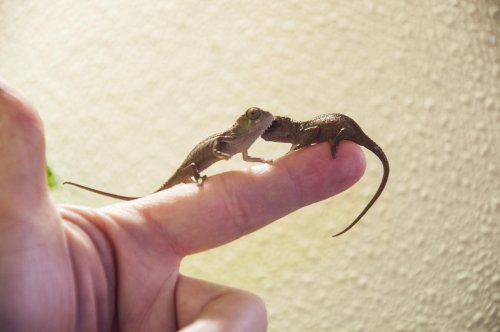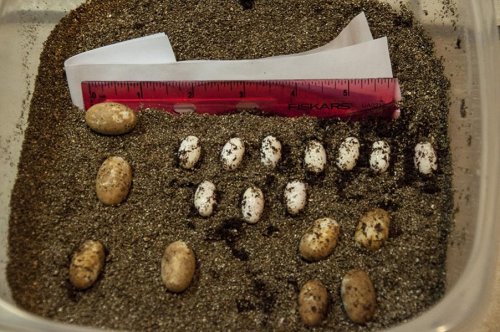pamnsam94
Established Member
At first I was sad. Now, I'm so amazed, shocked, and stunned! What adjectives would you use?  Let me explain.
Let me explain.
One of my 14 baby quads (coming up on 6 months at the end of this month) died yesterday. It was totally unexpected. She was one of the smaller ones (the differences in growth rates seem more pronounced lately) but not the smallest. I'm not sure what happened, but I'm very disappointed.
After that shock, I was shocked in a good way. I'm getting ready to go on a 2 1/2 week vacation to Florida, so I thought I'd better check on the 8 huge eggs, laid on 9/26/12 and mentioned in another thread, and the 10 eggs laid by the same female the very next day. Good thing I did because all 8 of the huge eggs have hatched! Unbelievable!!! As stated in my other thread, a couple of the huge eggs had what appeared and felt like egg white oozing from a miniscule hole. I figured those eggs had simply "burst" due to expanding beyond the capability of the flexible, leathery shell. After all, they have to have a limit as to how much they can expand, right?
As stated in my other thread, a couple of the huge eggs had what appeared and felt like egg white oozing from a miniscule hole. I figured those eggs had simply "burst" due to expanding beyond the capability of the flexible, leathery shell. After all, they have to have a limit as to how much they can expand, right?
I've been really busy lately because I took a second job to help pay for our vacation and Christmas. So, yesterday was the first time I checked on the eggs. I would've normally checked on the eggs by now to remove any bad eggs, etc., but I never thought I would need to check for neonates.
I have no idea how long ago they hatched. Does anyone know how long neonates have been known to survive in the container they hatched in? In any case, quads hatching in this short of a time (24 days or less) has to be some sort of record. Anyone else ever experience something like this?
Anyone else ever experience something like this?
I'm really curious what is meant when it is said the embryo will "drown" if the eggs are turned. Bird eggs need to be turned, but reptile embryos will die if turned once development starts. I want to know what happens physiologically.
From this experience, I now know that well developed embryos can even be turned upside down (as would happen as the mother climbs around) in oviparous species, not just ovoviviparous species. However, once the eggs are laid (in situ), it's completely different. The embryos at that point start getting oxygen through the permeable eggshell, as opposed to getting it through the mother's blood, and I suppose that has something to do with why the embryo will die if the egg is turned after a certain period. Any of you who know, please fill me in. Thanks.
I've been so busy that I was a little surprised to see that the eggs were laid almost a month ago! It seems like only 2 weeks ago. Besides having 8 more babies, the other good news is that the 10 normal sized eggs, laid by the same female the following day, still look really good. Normally, I would find it hard to wait 5 months (the "normal" incubation time), but given the unexpected 8 that I now have, I can use a break. I just hope these guys will do as well as the babies I currently have.
I just hope these guys will do as well as the babies I currently have.
The final good news is that these 8 and the 10 eggs yet to hatch are all completely unrelated to the 13 babies I now have. Their father is the 5-horned male in my avatar. I'm still sad that I lost the little female yesteday. I wish I knew the reason. I guess it's all part of the ups and downs of chameleon keeping. I don't think I've ever used so many smiley faces.
I don't think I've ever used so many smiley faces. 
Perry
One of my 14 baby quads (coming up on 6 months at the end of this month) died yesterday. It was totally unexpected. She was one of the smaller ones (the differences in growth rates seem more pronounced lately) but not the smallest. I'm not sure what happened, but I'm very disappointed.
After that shock, I was shocked in a good way. I'm getting ready to go on a 2 1/2 week vacation to Florida, so I thought I'd better check on the 8 huge eggs, laid on 9/26/12 and mentioned in another thread, and the 10 eggs laid by the same female the very next day. Good thing I did because all 8 of the huge eggs have hatched! Unbelievable!!!
I've been really busy lately because I took a second job to help pay for our vacation and Christmas. So, yesterday was the first time I checked on the eggs. I would've normally checked on the eggs by now to remove any bad eggs, etc., but I never thought I would need to check for neonates.
I have no idea how long ago they hatched. Does anyone know how long neonates have been known to survive in the container they hatched in? In any case, quads hatching in this short of a time (24 days or less) has to be some sort of record.
I'm really curious what is meant when it is said the embryo will "drown" if the eggs are turned. Bird eggs need to be turned, but reptile embryos will die if turned once development starts. I want to know what happens physiologically.
From this experience, I now know that well developed embryos can even be turned upside down (as would happen as the mother climbs around) in oviparous species, not just ovoviviparous species. However, once the eggs are laid (in situ), it's completely different. The embryos at that point start getting oxygen through the permeable eggshell, as opposed to getting it through the mother's blood, and I suppose that has something to do with why the embryo will die if the egg is turned after a certain period. Any of you who know, please fill me in. Thanks.
I've been so busy that I was a little surprised to see that the eggs were laid almost a month ago! It seems like only 2 weeks ago. Besides having 8 more babies, the other good news is that the 10 normal sized eggs, laid by the same female the following day, still look really good. Normally, I would find it hard to wait 5 months (the "normal" incubation time), but given the unexpected 8 that I now have, I can use a break.
The final good news is that these 8 and the 10 eggs yet to hatch are all completely unrelated to the 13 babies I now have. Their father is the 5-horned male in my avatar. I'm still sad that I lost the little female yesteday. I wish I knew the reason. I guess it's all part of the ups and downs of chameleon keeping.
Perry
Last edited:









